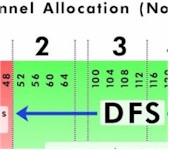
Read on SmallNetBuilder

I believe this is a design choice by ASUS. As long as the 60 second channel availability check is done and the channel is found clear, DFS channels can be reused.I guess what I don't understand is why, once the non occupancy period is over, the router don't revert to dfs channels again i.e. spread themselves out across the spectrum. Is this deliberate or just Asus design?
I believe this is a design choice by ASUS. As long as the 60 second channel availability check is done and the channel is found clear, DFS channels can be reused.
Yep - most of the DFS logic is in the chipset itself and configured at run-time by the OEM driver..
admin@Stargate88:/tmp/home/root# nvram show | grep acs | grep wl1 | grep dfs
size: 65119 bytes (65953 left)
wl1_acs_dfsr_activity=30 10240
wl1_acs_bgdfs_ahead=1
wl1_acs_bgdfs_idle_frames_thld=36000
wl1_acs_bgdfs_enab=1
wl1_acs_dfsr_immediate=300 3
wl1_acs_dfsr_deferred=604800 5
wl1_acs_bgdfs_idle_interval=3600
wl1_acs_bgdfs_avoid_on_far_sta=1
wl1_acs_dfs=0A lot is configured through the acsd daemon (which is responsible for handling channel selection). I see quite a few nvram values (which might be hardcoded by the CFE tho, and not be user-editable). A few that caught my eye:
There may be routers that support DFS but less clients do especially other devices besides PCs.
The spec says all connections must be dropped, i.e. no further packets sent on the channel when the channel is vacated.Hello. When router detects a radar signal and changes channel, does it cut i tenet connection to wifi clients at that moment? Or will it cause lag spikes?

Welcome To SNBForums
SNBForums is a community for anyone who wants to learn about or discuss the latest in wireless routers, network storage and the ins and outs of building and maintaining a small network.
If you'd like to post a question, simply register and have at it!
While you're at it, please check out SmallNetBuilder for product reviews and our famous Router Charts, Ranker and plenty more!
